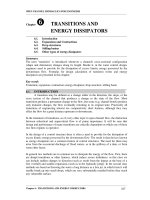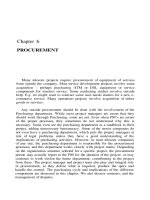Lecture E-commerce and e-business for managers - Chapter 6: Wireless internet and m-business
Bạn đang xem bản rút gọn của tài liệu. Xem và tải ngay bản đầy đủ của tài liệu tại đây (1.15 MB, 35 trang )
Chapter 6, Wireless Internet and m
Business
Outline
6.1
6.2
6.3
6.4
6.5
6.6
6.7
6.8
6.9
6.10
6.11
Introduction
Wireless Devices
mBusiness
Wireless Internet Access
Wireless Web Technology
6.5.1
Web Clipping
6.5.2
WAP and WML
Software Applications for Wireless Devices
Wireless Local Area Networks (WLANs)
Bluetooth
Wireless Communications
Location Tracking
6.10.1 Global Positioning System
6.10.2 E911 Act
Future of Wireless Internet
6.11.1 Implications for Disabled People
6.11.2 Ultimate Wireless Device
2001 Prentice Hall, Inc. All rights reserved.
6.1 Introduction
• Wireless technology turns ebusiness into m
business, or mobile business
• Current applications
–
–
–
–
Conduct online transactions
Make purchases
Trade stocks
Send email
• Future applications
– A wireless office, where computers, phones and other office
equipment are all networked without cables
2001 Prentice Hall, Inc. All rights reserved.
6.2 Wireless Devices
• Wireless development
– Firstgeneration wireless technology was the cellular phone
– Second generation wireless technology, which includes
digital cellular phones, is currently in use worldwide
– Third generation, or 3G technology will enable wireless
devices to send and receive data as much as seven times
faster than a standard 56K modem
• Wireless devices
– Personal digital assistants (PDAs)
– Digital cellular phones
– Twoway pagers
2001 Prentice Hall, Inc. All rights reserved.
6.2 Wireless Devices
• Outside the United States, mobile phones are the
preferred medium for getting information and
making ebusiness transactions
• Service is not universally available and still
relatively expensive
• Limited bandwidth restricts the amount of data
that can be sent over the wireless network
• Wireless devices have significantly smaller
memory capacity and less powerful processors
than desktop computers
2001 Prentice Hall, Inc. All rights reserved.
6.3 mBusiness
• mBusiness
– eBusiness using wireless devices with Internet access
– B2C marketplace
• Increased conveniences for consumers
• Frequent, small transactions
• Receiving news, sports scores, email, coupons and
advertisements
– B2B marketplace
• Salespeople can access product databases and place orders
• Address customer needs immediately
• Ordering and billing will be conducted remotely
2001 Prentice Hall, Inc. All rights reserved.
6.3 mBusiness
• Blackberry
– BlackBerry Exchange Edition
– BlackBerry Internet Edition
2001 Prentice Hall, Inc. All rights reserved.
6.3 mBusiness
Blackberry Home Page. (Courtesy of Research in Motion Limited. The Blackberry and RIM families of
related marks, images and symbols are the exclusive property of, and trademarks of Research in Motion
Limited, used by permission.)
2001 Prentice Hall, Inc. All rights reserved.
6.4 Wireless Internet Access
• Code Division Multiple Access (CDMA)
– Each transmission is assigned a specific channel, giving the
transmission the benefit of the entire bandwidth within that
channel and reducing the possibility that a connection will
be broken
– Able to assign each transmission on the network a unique
code to ensure security
• Global System for Mobile Communications (GSM)
– Uses Time Division Multiple Access (TDMA) which takes
multiple calls and assigns each call to a different time slot on
the same radio frequency
2001 Prentice Hall, Inc. All rights reserved.
6.4 Wireless Internet Access
• 3G technologies
– EDGE
– Cdma2000
– WCDMA
• International Telecommunications Union (ITU)
– Establishes guidelines for 3G
2001 Prentice Hall, Inc. All rights reserved.
Sprint PCS
• Sprint PCS
– A nationwide network that offers an array of wireless solutions for
both business and personal applications
• The main technology driving the PCS network is CDMA
• UP.Browser
– Sprint’s wireless Web browser
– Users can view Web sites designed for wireless Web browsers
• Wireless Web Connection Kit
– Allows customers to use their PCS phones as modems to connect
their laptops to the Internet over the Sprint PCS network
• Wireless Web Updates
2001 Prentice Hall, Inc. All rights reserved.
GoAmerica
• GoAmerica
– Wireless Internet service provider
– Services include Internet access, Web browsing and email
capabilities for a variety of wireless devices, including PDAs
and twoway pagers
• Go.Web
– Wireless Web browser gives users access to email and Web
– Compresses sites to reduce download time
• MyGo.Web
– Allows users to access information specific to their needs
2001 Prentice Hall, Inc. All rights reserved.
6.5 Wireless Web Technology
• Three technologies are used to provide Web
access to wireless devices
– Wireless Application Protocol (WAP)
– Web clipping
– Microsoft’s Pocket Internet Explorer
2001 Prentice Hall, Inc. All rights reserved.
6.5.1 Web Clipping
• Web clipping
– Allows users to take relevant pieces of a Web site and
deliver it to a wireless device, eliminating excess content and
graphics
– Palm devices use Web clipping
• Proxy server
– Lies between client (such as a Web browser) and Web server
– Query is received by a proxy server controlled by the
wireless ISP
– Proxy server goes to the Web site and “clips” the necessary
data
• The proxy server transmits the data back to your wireless
device
• If the proxy server does not have the information, it passes the
request to the regular server
2001 Prentice Hall, Inc. All rights reserved.
6.5.1Personal Digital Assistants
• Palm VII wireless handheld computer
• Query Application Builder (QAB)
– Web designers build Palm Query Applications (PQAs) to be
installed on users’ Palm handheld computers
2001 Prentice Hall, Inc. All rights reserved.
6.5.1 Personal Digital Assistants
Palm Web Clipping Applications Library. (Courtesy of Palm, Inc.)
2001 Prentice Hall, Inc. All rights reserved.
6.5.1 Personal Digital Assistants
Palm VII Handheld. (Courtesy of Palm, Inc.)
2001 Prentice Hall, Inc. All rights reserved.
6.5.2 WAP and WML
• Wireless Application Protocol (WAP)
– Developed by Nokia, Ericsson, Motorola, etc.
– A set of communication protocols designed to enable
different kinds of wireless devices to communicate and
access the Internet
– Designed to standardize development across different
wireless technologies worldwide
– Intended primarily for Internetenabled digital phones,
pagers and other handheld devices
– Uses Web sites specifically designed for wireless handheld
devices that have small screens and lowbandwidth
constraints
2001 Prentice Hall, Inc. All rights reserved.
6.5.2 WAP and WML
• Wireless Markup Language (WML)
– The scripting language used to create Web content to be
delivered to wireless handheld devices, based on XML
– Removes “unnecessary” content from Web pages
– WML tags are used to “mark up” a Web page to specify how
the page should be formatted on a wireless device
– WML works with the WAP to deliver the content
– Similar to HTML, but it does not require input devices
• Microbrowsers
– Designed with limited bandwidth and limited memory
requirements
– Access the Web via the wireless Internet
2001 Prentice Hall, Inc. All rights reserved.
6.5.2 WAP and WML
• How wireless Internet works:
– A WAP gateway, which acts as a proxy server, receives the
request, translates it and sends it to the appropriate Internet
server
– Server responds by sending the requested WML document
– The WAP gateway parses this document's WML (i.e., it
analyzes the WML document, checking it for correctness)
and sends the proper text to the digital phone
• Deck
A WML document
• Card
– Consists of one user interaction, providing the WML
browser with a small, selfcontained document for browsing
2001 Prentice Hall, Inc. All rights reserved.
6.5.2 WAP and WML
Rendering a WML document using Nokia’s Browser. (© 2000 Nokia Mobile
Phones.)
2001 Prentice Hall, Inc. All rights reserved.
6.6 Software Appliances for Wireless
Devices
• No widely accepted standard for wireless
development
• Developers are often required to develop multiple
applications
• Microsoft Pocket Internet Explorer
– Reformats complete Web pages as they are downloaded
from the Internet for display on the Pocket PC
– Allows Pocket PC users to access most of the content
currently available on the Web and eliminates the need to
tailor Web content for delivery to handheld devices
• PacketVideo
– Specializes in wireless video technology for mobile devices
2001 Prentice Hall, Inc. All rights reserved.
6.6 Software Appliances for Wireless
Devices
Microsoft Pocket PC Devices. (Courtesy of Microsoft Corporation, Casio Computer
Co., Ltd., Compaq Corporation, Hewlett Packard and Symbol Technologies, Inc.)
2001 Prentice Hall, Inc. All rights reserved.
6.6 Software Appliances for Wireless
Devices
Microsoft’s Pocket Internet Explorer. (Courtesy of Microsoft Corporation
and Compaq Corporation.)
2001 Prentice Hall, Inc. All rights reserved.
6.6 Software Appliances for Wireless
Devices
Demo of a video delivered to a wireless device using PacketVideo. (Courtesy of
PacketVideo Corporation.)
2001 Prentice Hall, Inc. All rights reserved.
6.7 Wireless Local Area Networks
• Easier to install and maintain without disrupting
an office
• Computers can easily be moved without having to
install a new network connection in each location
• Radio Frequency WLANs (RF WLANs)
– Used to network devices at a distance
• Infrared and laser WLANs
– Do not require FCC approval
– Do not have the same interference issues
– Can be used only for short distances
2001 Prentice Hall, Inc. All rights reserved.









